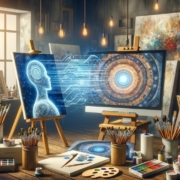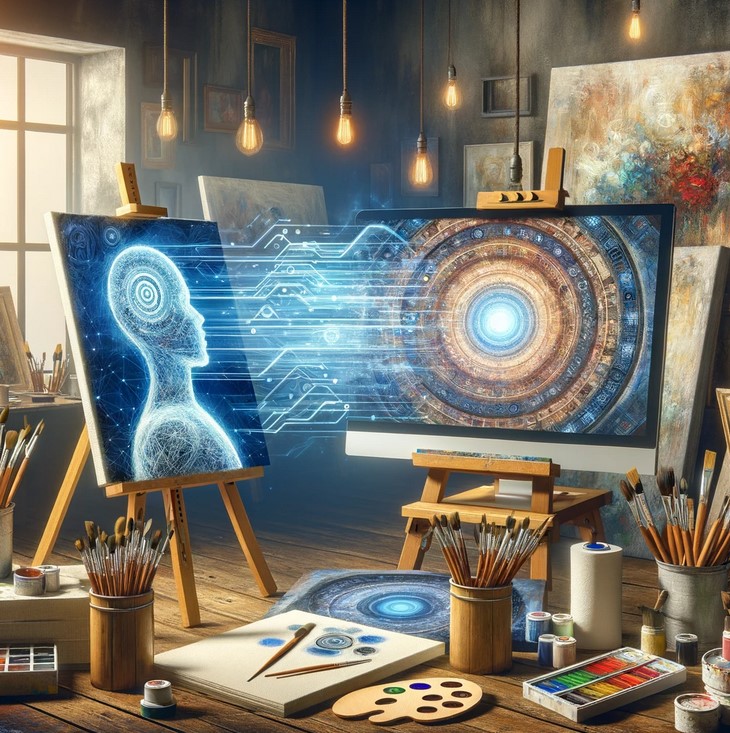(AMZN), (TSLA), (AAPL), (DIS), (NFLX), (CYBR), (PANW)
In the world of technology, art has always been a silent yet potent influencer. After all, the fusion of art and technology isn't just fascinating, it's downright profitable – if you know where to look.
Think Steve Jobs, whose calligraphy obsession led to the sleek typefaces we tap out texts on. Or take Jeff Bezos – ever wondered why Amazon’s (AMZN) Alexa sounds less like a robot and more like a "Star Trek" character? And don't get me started on Elon Musk – Tesla's (TSLA) quirky volume controls are a straight lift from the cult classic "This Is Spinal Tap."
Now, as AI's wave is about to crash over us, it's clear – art is no longer just influencing technology; it's actually steering it, with serious implications for those of us with skin in the investment game.
At a recent London tech summit, the buzz was all about artificial intelligence – a safer, more ethical version, which emulates Apple’s (AAPL) practices over Skynet. And this debate isn’t only some idle tech chatter, but a massive shift in how we build and invest in technology.
In this day and age, it’s becoming more and more apparent that ethical AI isn't just a nice-to-have; it's a must-have, and this requirement is catching on fast.
Now, here's where it gets pretty interesting. The summit turned into a battleground of sorts – traditional creatives on one side, AI-driven avatars on the other. This is where the future's being written, folks.
The issue is no longer confined to whether AI will complement human creativity; it has expanded to raise the question of whether this rapidly developing technology will replace it.
And for those looking into joining the fray, that's actually where the goldmine – or the landmine – lies, especially in sectors like entertainment where names such as Disney (DIS) and Netflix (NFLX) are key players.
Let's dive into the nitty-gritty, and talk about the data that trains these AI systems.
Remember the Hollywood writers' strike? That was about rights and royalties. Now, amplify that to AI scale. Given the potential of this sector, it’s imperative to keep your eyes peeled. This is where the future of companies neck-deep in AI tech will be decided.
Let’s move forward to discussing the elephant in the room: where does inspiration end and plagiarism begin in the age of AI?
When an AI can take a dollop of human creativity and turn it into something new, the old rules of authorship don't quite cut it. This isn't academic – it's a legal minefield that companies like Adobe (ADBE) and Autodesk (ADSK) are navigating as we speak. As pioneers, they're not just making tools; they're writing the rulebook for AI in creativity.
Moreover, as AI reshapes creativity, data security, and privacy are not just IT problems; they're boardroom problems. Companies like CyberArk Software (CYBR) and Palo Alto Networks (PANW) are on the front lines here.
Protecting IP and sensitive data in the AI age is a whole new ballgame, and these firms are playing to win. For investors, this is a key piece of the puzzle – security isn't just about keeping out the bad guys; it's about paving the way for safe, ethical AI use in creativity.
To wrap this up: the AI and art nexus is more than a clash of cultures; it's a fusion of possibilities. For the savvy investor, it's a field ripe with opportunities – in sectors that blend human creativity with AI's precision.
As we delve deeper into this new territory, the lessons learned will ripple across sectors, shaping investment strategies and redefining our relationship with technology. Striking the right balance between creativity and AI isn't just good for society; it's smart investing. Watch this space – the AI revolution in art is just getting started, and it's going to be a wild ride.




